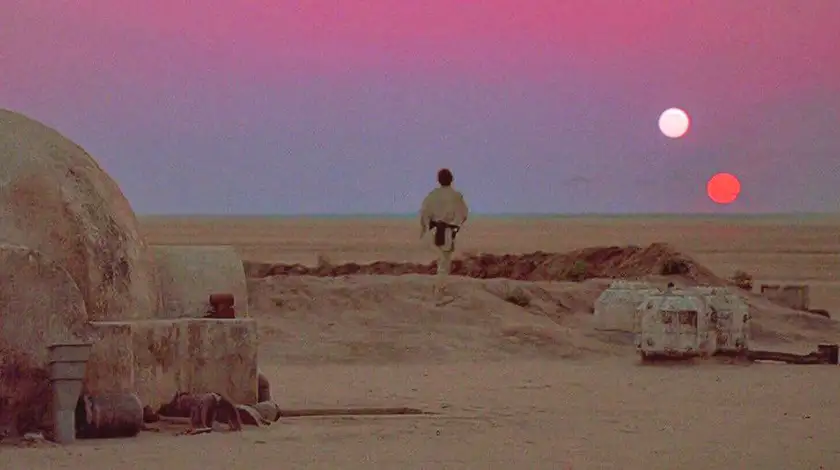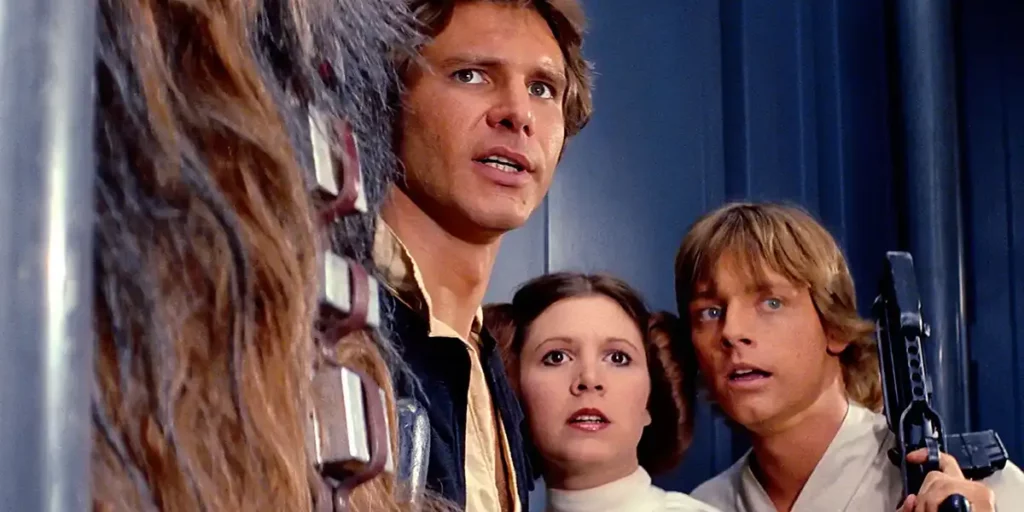Whether it is nostalgia or the importance of the film’s message, Star Wars: Episode IV – A New Hope still speaks to its viewers today.
Just like for many other fans of the franchise, Star Wars: Episode IV – A New Hope was one of the first science fiction films I ever watched and, of course, my introduction to the Star Wars saga. Maybe that is why it has always been my favourite of the series: after all, how could it not be? It is the audience’s first introduction to the Star Wars universe and the characters that populate it. In recent years, I also revisited this film in various ways: on the big screen, with a live orchestra playing, and even as part of my Hollywood Cinema class. With every rewatch, I’ve come to realise that there is so much more to A New Hope than simple nostalgia.
Set a long time ago in a galaxy far far away, A New Hope starts with Princess Leia Organa (Carrie Fisher), one of the leaders of the Rebel Alliance against Darth Vader (David Prowse) and the Galactic Empire her commands. She is taken hostage but manages to steal the architectural plans of the Death Star, a colossal space station built by the Empire. After Leia entrusts two droids R2-D2 (Kenny Baker) and C-3PO (Anthony Daniels) with this important information, the two escape to Tatooine where they meet Luke Skywalkers (Mark Hamill), Ben Kenobi (Alec Guinness), and Han Solo (Harrison Ford). The group then sets out on a mission to rescue Leila and deliver the architectural plans to the Rebel Alliance, in the hope of destroying the Death Star and Darth Vader once and for all.
One of the most memorable scenes of A New Hope is at the very beginning: Luke has an argument with his uncle, who won’t let him leave the planet despite Luke wanting to join his friends at the Rebel flight academy. Luke feels defeated, as he is forced to remain on the farm for longer than he intended, and walks away. As he steps outside, we witness the iconic binary sunset in Tatooine: the sky is now tinted with shades of purple and pink as two suns are about to set on the planet, a red one closer to the horizon and a white one that follows its descent.

The iconic theme written by John Williams, which is incredibly important to A New Hope, also plays in the background, suggesting an idea of hope and wonder for what is to come. As Luke looks into the horizon and wonders about his future, the audience gains an insider look at the galaxy in Star Wars, which is somehow both widely different and similar to our very own reality; we may be familiar with sunsets, but we’ll never witness one with two suns. It is not only a beautiful shot, but it’s also simultaneously familiar and unique, encapsulating the overall feeling of the Star Wars saga and Lucas’ ability to take well-known tropes – good against evil or the mentor and apprentice relationship – and innovate them in an entirely new setting.
The binary sunset has become one of the most famous images of Star Wars, and it has been featured again later in the franchise. It also suggests the binary of A New Hope, a film that, at its very core, is all about the fight of good against evil. Ultimately, it is very clear that the whole Star Wars saga still attracts universal appeal to this day, almost fifty years after the first instalment of the franchise came out in 1977. While a lot of it may certainly be due to the nostalgia the film invokes in its audience, there is also something timeless about its themes and plot.
When A New Hope was first released, it spoke to the widespread disappointment and general disillusionment with the United States and the future of the country in the face of the long and costly Vietnam War. In this sense, it almost stood as a beacon of hope and an important reminder that good and everyday heroism can be found even in a world that may only seem cruel and evil. This message was urgent in the 1970s and 1980s but is perhaps even more needed today, in a world that is just as polarized and torn apart by internal and external conflicts as the one George Lucas depicts on the screen.
In a world where it increasingly feels like every science fiction movie is attempting to be the new Star Wars – just think of Zack Snyder’s most recent directorial endeavour, Rebel Moon – watching A New Hope can even feel refreshing in the way that it introduces audiences to what has now become an iconic and beloved franchise. But, more than anything else, the film’s message, themes, and metaphor remain powerful and also very much needed in today’s world, just as much – if not even more – than they were when it was first made.
Star Wars: Episode IV – A New Hope is now available to watch on digital and on demand. Read our reviews of Return of the Jedi and Revenge of the Sith!

